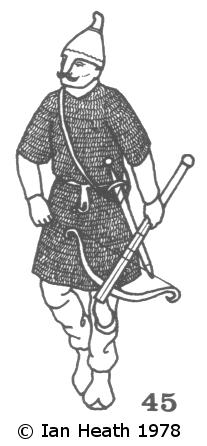SARACEN CROSSBOWMAN
An extract from Armies and Enemies of the Crusades 1096-1291
by Ian Heath
[based on the Chronica Majora by Matthew Paris]

45. SARACEN CROSSBOWMAN
During the Crusades the crossbow soon earned a healthy respect from the Moslems for its accuracy and deadliness and they quickly adopted the weapon themselves
(though it may have been in use in parts of Persia as early as the 9th century).
In fact the Saracen crossbow (often called the Qaws Farangi or Frankish Bow) was a superior weapon to that of the Franks,
using a composite bow as opposed to the simple self-bow used by the latter.
Al-Tartusi, speaking of crossbows, describes 4 different categories - the Qaws al-Rigl (or 'leg-bow', a name comparable to the 'one-foot crossbow' of Europe)
which was smallest, probably with a stirrup; the somewhat larger 'Aqqar, probably comparable to the 'two-foot crossbow';
the Garh, the largest, mounted on a stand for use in siege-work; and the Husban or 'grass-hopper',
apparently a crossbow with a barrel for shooting short, thick bolts, slingstones, or small naptha grenades.
He also describes the method of loading using a 2-clawed hook, attached to a toughened ox-hide belt, to pull back the string.
The Franks in turn adopted the composite crossbow from the Saracens, realising its superiority,
and for some time Levantine crossbows and their manufacturers were in high demand in Europe;
King John of England's crossbow-maker, for instance, was Peter 'the Saracen', and King Louis IX's was John 'the Armenian'.
This figure is based on an illustration in Matthew Paris' Chronica Majora depicting the Ayyubid garrison of Kerak in 1241.
He wears mail and a helmet of a type which frequently appears in contemporary illustrations of Moslems, principally in Spanish sources.
In the original he is shown wearing an arming cap under the helmet.
The crossbow itself has been substituted from a 13th century
Egyptian military manual.
The stirrup is of interest since it appears to be of leather or rope rather than iron.
Next: 46. AYYUBID HEAVY CAVALRYMAN ACCORDING TO MATTHEW PARIS in Armies and Enemies of the Crusades 1096-1291 by Ian Heath

